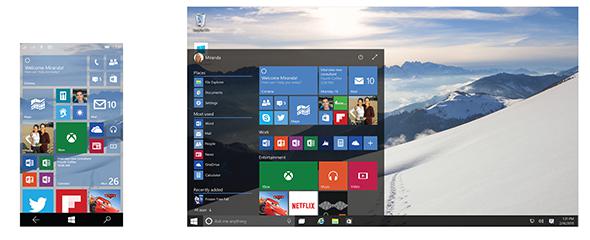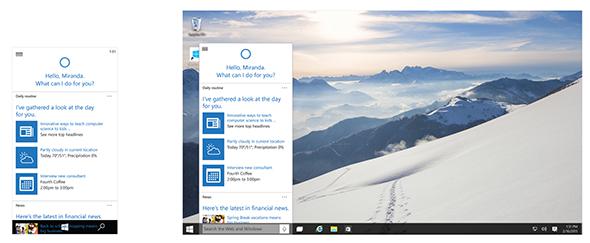I’m reluctant to say this, and there’s a very good chance I’ll end up regretting it. But on first glance, at least, Microsoft’s new operating system actually looks … kind of … well … good.
Looks can be deceiving, of course. When it comes to carefully staged demos of new tech products, they often are. But after the debacle that was Windows 8, I get the sense that Microsoft has poured everything it has into making sure its next major operating system does not disappoint.
On Wednesday, at an event in Redmond, Washington, the company gave the public its first up-close look at how Windows 10 will work. (An early “technical preview,” aimed at developers and IT pros, was released in September.) I, for one, was not disappointed.
Much is new here, from a sleek yet functional interface to a fresh Web browser to a starring role for Cortana, Microsoft’s answer to Siri. But the first thing to know about Windows 10 is that it’s designed to work across all of your Windows devices. You’ll have one basic operating system underpinning your PC, tablet, phone, and even Xbox. It will look slightly different on each, with mobile devices getting their own tailored version of the OS. But they’ll share a single app store, and you’ll be able to hand off files and settings between them. If you’re working on a hybrid computer, it will automatically switch between PC and tablet mode when you plug in or unplug your keyboard and mouse.
That’s a big development. If it works, Microsoft might begin to recapture the sort of ecosystem loyalty that has allowed Apple to hook people on entire families of devices, from Macs to iPhones to iPads and even Apple TVs.
If nothing else, it’s a huge boost to mobile devices running Windows, which until now have been crippled by a pathetic app store that has struggled to attract major developers. With PCs in the fold, the addressable audience for developers working on Windows apps grows by orders of magnitude. Apple has also been moving in the direction of unifying its mobile and desktop software, but Microsoft may have just leapfrogged it.
Microsoft started down this road with Windows 8, but it took a wrong turn. Rather than design an operating system versatile enough to adapt to each device, Microsoft foisted a tablet-style interface on its legions of PC users, confusing and enraging millions who had worked comfortably on Windows PCs for years. The move spawned a veritable cottage industry of blog posts on how to hack Windows 8 to make it more like its familiar predecessor, Windows 7.
With Windows 10, Microsoft has revived PC-appropriate features like the Start Menu, which has been reworked into an appealing hybrid between the icon-based classic menu and the active tiles introduced in Windows 8. With one touch (or click), you can take the Start Menu full screen, and you’re thrust back into an environment that looks a lot like Windows 8. But if you don’t like the tiles on your PC, you don’t have to use them.

Courtesy Microsoft
The integration across devices will allow you to do things like play some Xbox One games on your PC or tablet and use some “universal” Windows apps, including Skype, on your Xbox. A new notification center, called the Action Center, will deliver alerts to your PC as well as your phone or tablet.
Cortana, Microsoft’s answer to Siri, will also make the leap from mobile to desktop—something Siri itself has yet to do. Judging from its presentation Wednesday, Microsoft envisions Cortana as the new universal command center and search function for all your Windows devices, sort of like Siri, Apple’s Finder, and Google Now rolled into one. On the desktop, Cortana will live in the taskbar, but will leap into action when you say “Hey Cortana.”
“Hey Cortana,” Microsoft VP Joe Belfiore said on stage Wednesday, talking to a computer. “Hey Joe,” it replied.
“Do I need a coat tomorrow?” he asked. “You could probably go without one,” it predicted, and proceeded to give him a brief rundown of Thursday’s local weather. (Microsoft executives kept calling Cortana “she,” but I refuse to do that. It’s an it, not a person, and its don’t have a gender in the English language.)
I’m skeptical that normal, socialized humans will start holding conversations with their desktop PCs anytime soon. But people are already talking to their phones, and soon they’ll be talking to their cars, too. Microsoft is right to anticipate a shift toward more natural interactions between humans and computers.
The real question is how intelligent Cortana can get. Siri has been a disappointment for Apple, because a personal assistant that only understands one-half of your questions is not a very good personal assistant. Google Now, on the other hand, has found its way to usefulness by ditching the chit-chat and quietly keeping track of your appointments, purchases, travel plans, and interests across disparate services like search, email, and the Web browser. It looks like that’s what Microsoft is going for with Cortana, too. But in a deft marketing move, Microsoft will make it easy for users to see exactly what Cortana has learned about them, so that it doesn’t feel like a creepy black box. Just ask Cortana, “What do you know about me?” and it will reply by opening a notebook in which it stores your interests and predilections as it learns them. “You are our customer, not our product,” executive vice president Terry Myerson assured the audience, in an unsubtle dig at Mountain View.

Courtesy Microsoft
Another place Cortana will work is in Microsoft’s new Web browser, code-named Spartan. There, it will do Google-y things like pull up the information for your next flight when you type “Delta” into the search bar. Another potentially nifty Spartan feature: You can mark up Web pages with your own comments, highlights, and scribblings, then share them with others.
These types of features might catch on, or they might turn out to be gimmicks. But even if it’s the latter, they speak to what appears to be a new spirit of—dare I say it?—innovation at Microsoft. That spirit has peeked through at times in recent years as the company has begun to adjust to its underdog status in mobile technology. It has mostly come in the form of surprising new hardware projects like Xbox Kinect and the Microsoft Surface’s elegant Touch Cover keypad.
On Wednesday, it was on full view, from Windows 10 to Spartan to a strange, massive new 84-inch Microsoft Surface designed for fancy conference rooms. Most bizarre and daring of all was a new device called the HoloLens, a holographic augmented-reality headset that you control with gestures, eye movements, and voice commands. It looks like a mash-up of Google Glass and Oculus Rift, and it will probably be a spectacular failure. But it might not be! More importantly, it looks like something you’d expect from a high-flying startup, not a down-on-its-luck tech titan mired in bureaucracy and design by committee.
Windows 10 might yet crash and burn for reasons that won’t become apparent until everyone upgrades to it. (The public release is expected sometime this fall.) But Microsoft appears to have learned quite a bit from the Windows 8 debacle. With Windows 10, it has enrolled some 1.7 million computer wonks in its Windows Insider Program, where they’ve been testing previews of the new operating system for months and showering Redmond with feedback. “We’re listening,” Myerson said.
That actually seems to be true. One bit of evidence: For the first year after its release, Microsoft will offer Windows 10 as a free upgrade for Windows 7 and Windows 8.1 users. And it will continue to update the OS on every device that upgrades to Windows 10, for as long as that device is supported.
New CEO Satya Nadella said Wednesday that the company has fundamentally reconsidered the role and value of Windows in a world where it is no longer everyone’s default operating system. “We want to move from people needing Windows to choosing Windows, to loving Windows.”
I have never loved Windows, and I don’t expect to anytime soon. But even a halfway-likeable Windows might be enough to get the company going in the right direction again, given its still-dominant desktop market share. The tech world could also really use a third viable mobile operating system to challenge the Android/iOS duopoly.
Welcome back, Microsoft. Keep it up, and who knows: Someday you might even be worth hating again.
